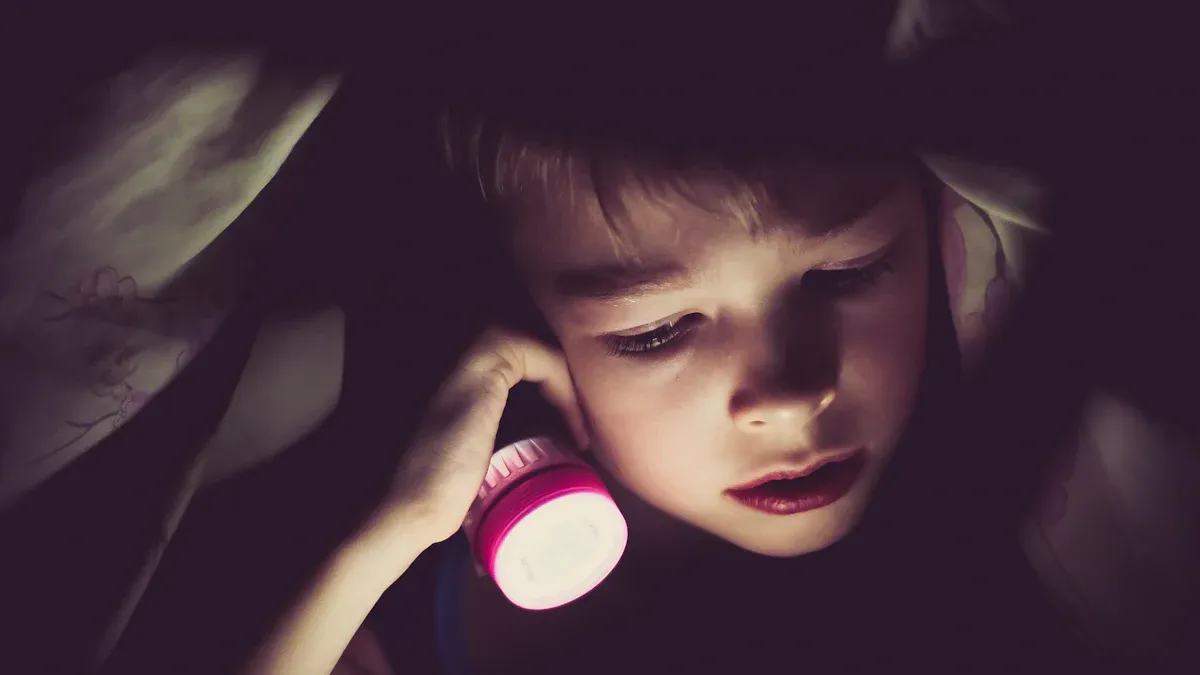Common Flashlight Errors and Simple Ways to Avoid Them

Using a flashlight might seem simple, but mistakes can lead to frustration or even danger. Imagine needing light during a power outage, only to find your flashlight dead or ineffective. Proper flashlight using ensures you're prepared when it matters most. Avoiding common errors saves time, money, and keeps you safe in emergencies.
Key Takeaways
Pick a flashlight that fits your needs. Think about how bright it is, its size, and how strong it is for emergencies.
Check your flashlight batteries often. Change or charge them so you’re not stuck without light when you need it.
Buy good-quality flashlights. Choose trusted brands and strong materials to make sure it works well and lasts long.
Choosing the Wrong Flashlight

Picking the wrong flashlight can leave you in the dark—literally. To avoid this, you need to think about how and where you'll use it. Let’s break it down.
Not Considering the Intended Use
Every flashlight serves a purpose. Are you camping, hiking, or just keeping one at home for emergencies? For camping, you’ll want long battery life and multiple modes for tasks like cooking or navigating. Hiking calls for something compact and lightweight that won’t weigh you down. For general use, a flashlight with at least 200 lumens works well for most situations.
Durability is key for outdoor adventures. Flashlights made from materials like aluminum or stainless steel can handle drops and impacts. Waterproof designs ensure they work even in rain or snow.
Overlooking Brightness and Beam Distance
Brightness matters more than you might think. A flashlight with 200 to 1000 lumens is ideal for most outdoor activities. Lower lumens (50-100) are fine for general use, while higher lumens (100-500) suit camping or night running. Beam distance is equally important. A longer beam helps you see farther, which is crucial for hiking or exploring unfamiliar areas.
ANSI FL1 Standards test flashlights for brightness, beam intensity, and battery runtime. These standards ensure you get reliable performance.
Ignoring Portability and Size
A bulky flashlight can be a hassle. For hiking or camping, choose a lightweight, compact model that fits easily in your bag. At home, a slightly larger flashlight with a sturdy grip might be more practical. Always balance size with functionality to ensure it meets your needs.
Ignoring Battery Maintenance
Battery maintenance is one of the most overlooked aspects of flashlight care. Without proper attention, you might find yourself in the dark when you need light the most. Let’s explore some common mistakes and how to avoid them.
Using Incompatible Batteries
Not all batteries work with every flashlight. Using the wrong type can damage your flashlight or reduce its performance. Always check the manufacturer’s recommendations before buying batteries. Stick to high-quality options for better reliability. If your flashlight doesn’t turn on, inspect the battery installation and contacts for corrosion. Replace or recharge the batteries as needed to keep your flashlight ready for action.
Forgetting Regular Battery Checks
When was the last time you checked your flashlight batteries? If you can’t remember, it’s probably time to do so. Batteries lose charge over time, even when not in use. Regularly test your flashlight to ensure it’s working properly. Replace the batteries if you notice a drop in brightness or if they no longer hold a charge effectively. This simple habit can save you from unpleasant surprises during emergencies.
Storing Flashlights with Batteries Installed
Leaving batteries inside your flashlight for long periods can lead to leakage and corrosion. This damages both the batteries and the flashlight. To avoid this, remove the batteries when you’re not using the flashlight for extended periods. Store them separately in a cool, dry place. This small step can significantly extend the life of your flashlight and its batteries.
💡 Pro Tip: Use leak-proof batteries to minimize the risk of damage and keep your flashlight in top condition.
Overlooking Durability and Weather Resistance

When it comes to flashlights, durability and weather resistance are often overlooked. But these features can make or break your flashlight using experience, especially in challenging environments. Let’s dive into the common mistakes and how to avoid them.
Skipping Waterproof or Weatherproof Features
Have you ever been caught in the rain with a flashlight that suddenly stops working? That’s what happens when you skip waterproof or weatherproof features. A reliable flashlight should withstand exposure to water, whether it’s a drizzle or a downpour. Look for models with an IPX rating. For example, IPX4 means it’s splash-resistant, while IPX7 can handle submersion in water.
💡 Tip: If you’re planning outdoor adventures, choose a flashlight with waterproofing and resistance to extreme temperatures. These features ensure it performs well in unpredictable weather.
Neglecting Impact Resistance
Accidents happen. You might drop your flashlight on a rocky trail or a hard floor. Without impact resistance, it could break or stop working entirely. Flashlights made from materials like aluminum, stainless steel, or titanium are built to handle tough conditions. Titanium, in particular, offers a high strength-to-weight ratio and excellent corrosion resistance, making it ideal for rugged use.
Shockproof designs also help protect internal components, ensuring your flashlight stays functional even after a fall. Don’t settle for a product that can’t handle a little rough treatment.
Using Non-Durable Flashlights in Tough Conditions
Using a non-durable flashlight in extreme environments is a recipe for disaster. These flashlights often fail when you need them most. Some may even pose safety risks, like overheating or causing a fire. Manufacturers sometimes misrepresent certifications, so always verify claims before buying.
For demanding conditions, choose flashlights with robust materials like aluminum or titanium. Features like shockproof and weatherproof designs ensure consistent brightness and reliable performance, no matter the environment. A durable flashlight is an investment in your safety and peace of mind.
Relying on Low-Quality Products
When it comes to flashlights, quality matters. Choosing a low-quality product might save you money upfront, but it often leads to frustration and wasted time. Let’s explore some common mistakes you should avoid.
Choosing Cheap, Unreliable Flashlights
It’s tempting to grab the cheapest flashlight you can find, especially if you’re in a rush. But cheap flashlights often come with poor build quality, weak brightness, and unreliable performance. They might fail when you need them most, leaving you in the dark—literally. Instead, invest in a flashlight that’s built to last. Look for features like durable materials, consistent brightness, and reliable battery life. A good flashlight is an investment in your safety and convenience.
💡 Tip: Spending a little more upfront can save you from replacing flashlights frequently.
Skipping Brand and Review Research
Not all flashlights are created equal. Skipping research on brands and reviews can lead to disappointment. Some brands are known for their reliability and innovation, while others cut corners to lower costs. Before buying, check online reviews and ratings. Look for feedback on durability, brightness, and battery performance. This step helps you avoid products that don’t deliver on their promises.
Prioritizing Cost Over Quality
Focusing only on cost can backfire. A low price tag might seem appealing, but it often comes at the expense of quality. Flashlights made with cheap materials or poor craftsmanship are more likely to break or malfunction. Prioritize quality over cost to ensure your flashlight performs well when it matters. A high-quality flashlight might cost more initially, but it will save you money in the long run by lasting longer and requiring fewer replacements.
Remember, reliable flashlight using starts with choosing a product you can trust.
Failing to Prepare for Emergencies
Emergencies can happen when you least expect them. If you’re not prepared, even the best flashlight won’t help. Let’s look at some common mistakes and how to avoid them.
Not Keeping Spare Batteries or Flashlights
Imagine your flashlight dying in the middle of a power outage. That’s why having spares is essential. Always keep extra batteries and a backup flashlight in your emergency kit. Here’s what you should include:
Flashlight
Extra batteries for the flashlight
These simple additions can make a huge difference when you’re in a pinch. Rechargeable batteries are a great option, but make sure they’re fully charged before storing them. If you prefer disposable batteries, check their expiration dates regularly.
Forgetting Regular Flashlight Testing
A flashlight that doesn’t work when you need it is as good as useless. Test your flashlight every few months to ensure it’s in working condition. Turn it on, check the brightness, and inspect the batteries. If the light flickers or seems dim, replace the batteries immediately. Regular testing helps you avoid surprises during emergencies. It’s a quick task that can save you a lot of trouble later.
💡 Tip: Set a reminder on your phone to test your flashlight quarterly. This way, you’ll never forget.
Storing Flashlights in Inaccessible Locations
What’s the point of having a flashlight if you can’t find it when you need it? Store your flashlight in a cool, dry place that’s easy to access. Avoid direct sunlight to protect the materials and batteries. Keep it in a drawer, a bedside table, or a designated emergency kit. If you’re not using the flashlight for a while, remove the batteries to prevent leakage or corrosion. These simple steps ensure your flashlight is always ready to go.
Remember, proper flashlight using isn’t just about having one—it’s about being prepared to use it when it matters most.
How to Choose the Right Flashlight
Focus on Brightness and Beam Type
When choosing a flashlight, brightness and beam type are key factors. Brightness, measured in lumens, determines how much light your flashlight produces. For general use, 200-500 lumens work well, while 1000+ lumens are better for outdoor adventures or lighting up large areas. Beam type also matters. A flood beam spreads light over a wide area, perfect for close-up tasks. A spot beam focuses light in a narrow direction, ideal for long-distance visibility. Some flashlights even offer adjustable beams, giving you flexibility for different scenarios.
💡 Tip: Look for flashlights with ANSI FL1 ratings. These standards ensure reliable brightness and beam performance.
Evaluate Battery Type and Runtime
The type of battery your flashlight uses can impact its performance. Rechargeable batteries, like Li-Ion, are eco-friendly and cost-effective over time. Disposable batteries, such as alkaline, are easy to find but less sustainable. Runtime is equally important. A flashlight with long battery life ensures you won’t be left in the dark during extended use. For emergencies, consider flashlights with multiple power modes to conserve energy when needed.
Battery Type | Pros | Cons |
|---|---|---|
Alkaline | Affordable, widely available | Not rechargeable, lower power |
Li-Ion | Lightweight, high performance | Higher cost, fewer charge cycles |
Check for Durable, Weather-Resistant Materials
Durability is crucial, especially for outdoor or emergency use. Materials like aluminum and stainless steel provide excellent strength and resistance to wear. Aluminum is lightweight and great for portability, while stainless steel offers superior durability. For extreme conditions, titanium flashlights are a premium choice due to their exceptional strength-to-weight ratio. Always check for weatherproof ratings like IPX7, which ensures your flashlight can handle rain or even submersion in water.
Consider Portability and Ease of Use
A portable flashlight makes life easier. Compact and lightweight models are perfect for hiking or travel since they don’t add unnecessary weight to your gear. At the same time, ease of use is essential. Look for flashlights with intuitive controls, like a single button for switching modes. A flashlight that balances portability with functionality enhances your overall experience.
Remember, the right flashlight using habits start with choosing a model that fits your needs.
Avoiding common flashlight mistakes ensures you’re never left in the dark. Here’s a quick recap of the most frequent errors and their solutions:
Mistake Description | Explanation |
|---|---|
Relying on low prices when selecting flashlights | Flashlights priced at $20 or less often represent low quality and do not perform as advertised. |
Trusting high star ratings without further research | Many products with high ratings may not meet quality expectations, leading to poor purchasing decisions. |
Ignoring the importance of experience in flashlight selection | Experienced users can better identify quality and features that are appropriate for specific needs. |
Proper flashlight using starts with good habits. Regular cleaning every six months keeps your flashlight performing at its best. Remove batteries during long storage to prevent corrosion, and store your flashlight safely to avoid damage. These small steps make a big difference.
By choosing the right flashlight and caring for it properly, you’ll always have reliable light when you need it. Take these tips to heart and enjoy the peace of mind that comes with being prepared.
FAQ
What’s the best way to store a flashlight for emergencies?
Keep it in a cool, dry, and accessible spot. Remove the batteries to prevent leakage. A bedside drawer or emergency kit works great.
💡 Tip: Label your storage spot for quick access during emergencies.
How often should I test my flashlight?
Test it every 2-3 months. Turn it on, check the brightness, and inspect the batteries. Regular testing ensures it’s ready when you need it.
Can I use rechargeable batteries in any flashlight?
Not always. Check the flashlight’s manual for compatibility. Some models only work with specific battery types. Using the wrong ones can damage your flashlight.
⚠️ Note: Always follow the manufacturer’s recommendations for battery use.
See Also
Key Strategies for Proper Flashlight Upkeep and Care
Comprehensive Handbook for Maintaining and Cleaning Your Flashlight
Maximize Your Flashlight's Battery Life With These Helpful Tips
Five Key Considerations When Selecting Your Ideal EDC Flashlight
